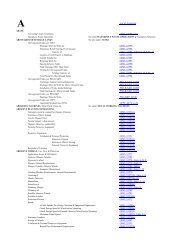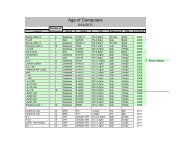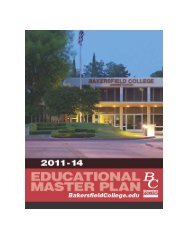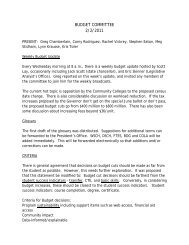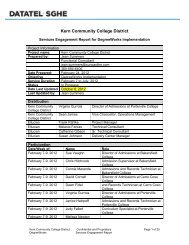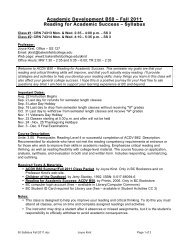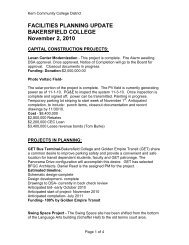Addendum with evidence (8.2 MB) - Accreditation - Bakersfield ...
Addendum with evidence (8.2 MB) - Accreditation - Bakersfield ...
Addendum with evidence (8.2 MB) - Accreditation - Bakersfield ...
Create successful ePaper yourself
Turn your PDF publications into a flip-book with our unique Google optimized e-Paper software.
Where the California Jobs Will Be In 2018 (in thousands of jobs)<br />
Occupation<br />
Some Associate B achelor's<br />
Group Occupation<br />
College % Degree % Degree % Total<br />
STEM Computer & Math Science 89 16% 45 8% 242 44% 545<br />
STEM Architects & technicians 13 20% 9 14% 25 38% 65<br />
STEM Engineers & technicians 34 11% 28 9% 141 44% 317<br />
STEM Life and Physical Scientists 9 6% 6 4% 45 32% 140<br />
STEM Social Scientists 5 6% 3 4% 27 33% 82<br />
Healthcare Healthcare Practitioners 109 13% 160 19% 239 29% 836<br />
Healthcare Healthcare Support 148 33% 51 11% 49 11% 448<br />
Source: Carnival, Anthony; Smith, Nicole; and Strohl, Jeff (2010). Help Wanted: Projections of Jobs and Educational<br />
Requirements Through 2018. Center on Education and the Workforce, Georgetown University.<br />
The pubic-private partnership known as the California Partnership for the San Joaquin<br />
Valley has identified five industry clusters that they believe should be targeted as part of the efforts to<br />
support a highly skilled workforce and promote a competitive economy in the Central Valley. The<br />
identified clusters are: (1) Agribusiness, including Food Processing, Agricultural Technology, and<br />
Biotechnology; (2) Manufacturing; (3) Supply Chain Management and Logistics; (4) Health and<br />
Medical Care; and (5) Renewable Energy. The Partnership envisioned high quality vocational<br />
training and academic institutions in the Central Valley that would educate the workforce. 7<br />
The Centers for Excellence have completed a series of environmental scans and studies to<br />
further document the occupational opportunities and related educational requirements in several of<br />
these targeted clusters. For example, the agriculture value chain is defined using four clusters: (1)<br />
support; (2) production; (3) processing and packaging; and (4) distribution statewide. Agriculture<br />
employs close to 2.5 million individuals <strong>with</strong> more than 800 job titles <strong>with</strong>in the agriculture value<br />
chain. When surveyed, a majority of the employers indicated an interest in on-site, customized<br />
training for current employees and a certificate specific to each occupation. Employers indicated<br />
some interest in two and four-year degree programs specific to an occupation. Two-thirds of the<br />
employers were interested in potential partnerships <strong>with</strong> colleges and in creating internship<br />
opportunities. With the exception of production, employment opportunities are positive in the other<br />
8<br />
three clusters over the next five years. The concluding recommendations in the study stressed the<br />
creation of partnerships and consideration for contract education as the mode of service delivery.<br />
7 California Partnership for the San Joaquin Valley. Strategic Action Proposal. October, 2006<br />
8 Centers of Excellence. Agriculture Value Chain for California. June, 2011<br />
78



